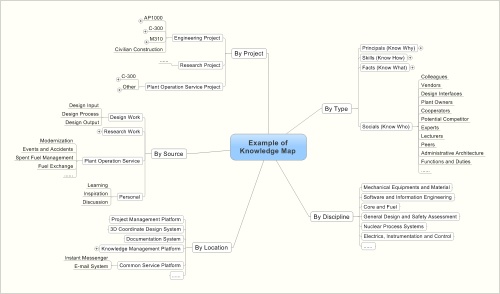Knowledge map
Contents
Definition
Knowledge map is A map of a selected knowledge domain.
Summary
Knowledge map is a tool which presents a selected knowledge domain and the connections within it in a graphical form. Knowledge maps can take several forms, e.g. concept map or process map. They can also be produced for different usage including a map of the knowledge of one person or a map of knowledge assets of a whole organisation.
Description
Overview
Knowledge map is a symbolic representation of selected knowledge domain and the output of knowledge mapping. The form of knowledge maps may vary including concept maps and process maps. The components of knowledge maps usually include the so-called background which is the context where the map is produced, the elements of the maps and the relationships between the elements. The last of which is the essential feature of a knowledge map compared to other ways of documenting knowledge, e.h. lists. An example of a knowledge map is provided in Fig 1.
Benefits of knowledge maps
For nuclear organizations, there are several benefits of using knowledge maps, including better overview, a faster access, and a more efficient and memorable representation and communication of knowledge assets.
Knowledge maps can also be used as a way of capturing implicit knowledge.
Objective of knowledge maps
Knowledge maps can be produced for varying purposes examples of which are provided below.
- Indicate the location of knowledge assets in an organization: The basic function of knowledge map is to tell users where they can get knowledge and to provide navigation for them. Similar to information explosion, sometimes there is excessive knowledge in an organization, which is over the limit for a person to handle. In spite of search engines, knowledge map can be a good manner to retrieve knowledge in a logical way.
- Help to discover tacit knowledge in an organization: With the overview picture of knowledge assets in an organization, it is more likely to discover tacit knowledge in certain fields. Behind the corelation of knowledge, there might be some experts and knowledge owners from whom tacit knowledge can be captured.
- Improve the self-learning ability in an organization and guide newcomers: Users(or employees) can learn new things by navigating in a knowledge map. Moreover, knowledge map is greatly helpful to newcomers and let them get into their roles quickly.
- As a summary list of knowledge assets in an organization: Knowledge map can be regard as a summary list of knowledge assets in an organization, which helps to evaluate the current status and maturity of knowledge management.
Classification knowledge maps
Te literature review of Eppler [4] provides several possible classifications for knowledge maps. The knowledge maps can be categories based on their purpose, i.e. which knowledge process they try to address. Maps can be created for example for learning, identification, acquisition, transfer etc. purposes.
Knowledge maps can also be categorised based on the knowledge domain they involve. Maps can also be created for several user groups. Some might be just for personal use and some for use of a whole organisation.
- Social-oriented knowledge map, or Personal network map or shows the social relationship of users(or employees) as well as their expertise and competencies in a knowledge map.
Producing a knowledge map
References
[1] Development of Knowledge Portals for Nuclear Power Plants
[2] Ermine J.L., Boughzala I and Tounkara T., Critical Knowledge Map as a Decision Tool for Knowledge Transfer Actions, "Electronic Journal of Knowledge Management 4, 2 (2006) 129-140, http://hal.archives-ouvertes.fr/docs/00/47/03/87/PDF/10.1.1.85.873_1_.pdf
[3] Balaid, Zibarzani, Rozan, A Comprehensive Review of Knowledge Mapping Techniques, JOURNAL OF INFORMATION SYSTEMS RESEARCH AND INNOVATION, http://seminar.utmspace.edu.my/jisri/download/F1_FinalPublished/Pub9_Comprehensive_KnowledgeMapping_Techniques.pdf
[4] Eppler M., A Process-Based Classification of Knowledge Maps and Application Examples, Knowledge and Process Management, Volume 15 Number 1 pp 59–71 (2008), http://lpis.csd.auth.gr/mtpx/km/material/knowledge%20maps.pdf


